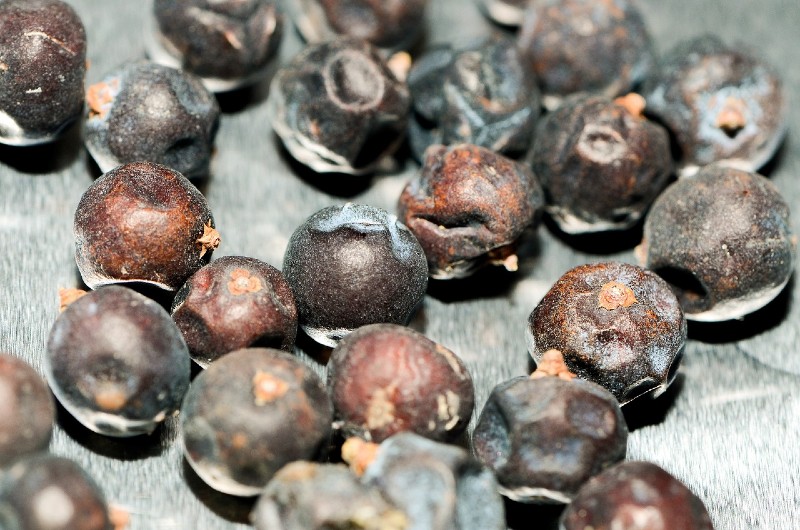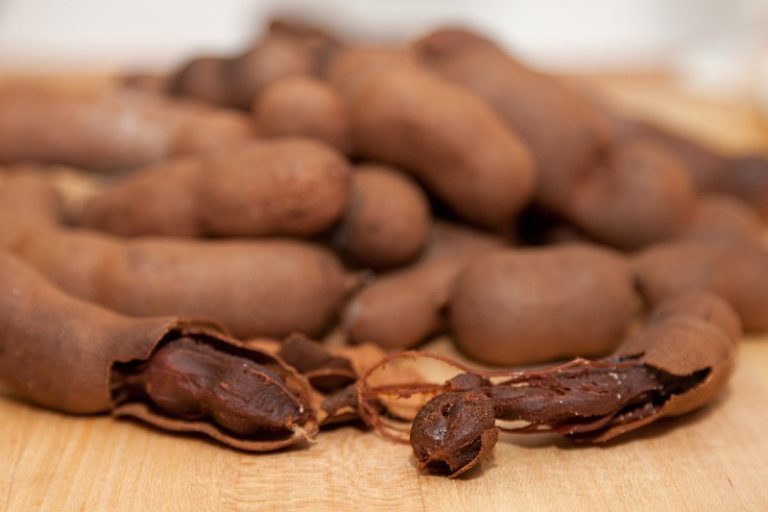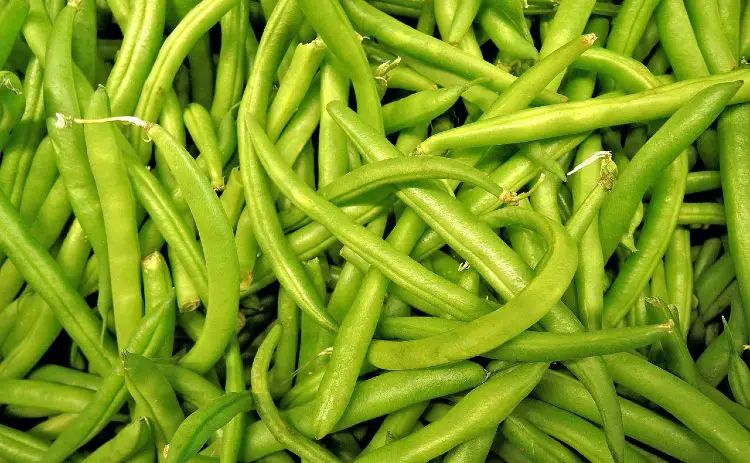Best Extraordinary Juniper Berry Substitutes You Must Try ASAP!
Juniper berries, with their distinct flavor profile that dances between sweet, spicy, and a unique hint of pine, have long been a favorite among chefs and culinary enthusiasts alike. These small, dark-colored berries aren’t true berries at all, but rather the female seed cone of the juniper shrub. Most notably, they play a pivotal role in the flavoring of gin, making it one of the world’s most recognized spirits.
But what do you do if a recipe calls for juniper berries and you don’t have any on hand? Or perhaps you’re catering to someone with an allergy, or maybe you simply want to experiment with a different flavor palette.
Whatever the reason, having an arsenal of substitutes for such a distinct ingredient can be a real lifesaver. Whether you’re aiming for a near-identical flavor or simply something that complements the dish well, the right substitute can make all the difference.
List of Juniper Berries Substitutes
Rosemary
When seeking a substitute for the distinct piney flavor of juniper berries, one of the first herbs that often comes to mind is rosemary. The parallels in their aroma and taste make rosemary a frontrunner in the race for suitable replacements.
Rosemary, a perennial herb with needle-like leaves, has a pronounced fragrance that is unmistakably reminiscent of pine. It shares a woody, evergreen scent with juniper berries, making it a natural choice for many recipes. However, unlike juniper berries, rosemary lacks the peppery and sweet undertones, which means that when substituting, additional adjustments might be needed to replicate the full flavor profile.
Best Uses in Recipes
- Meat dishes: Just as juniper berries shine when paired with game meats, so does rosemary. It’s particularly wonderful with lamb, beef, and poultry, lending a fragrant aroma that permeates the meat.
- Vegetables: Rosemary’s robust flavor complements root vegetables beautifully. Consider using it with potatoes, carrots, or parsnips for a dish that resonates with earthy tones.
- Soups and Stews: For broths and stews that call for juniper berries, rosemary can add a similar depth of flavor. It’s worth noting, however, that rosemary can be quite potent, so it’s advisable to start with a small amount and adjust to taste.
- Sauces: Whether it’s a reduction for a steak or a base for pasta, a touch of rosemary can introduce the desired piney notes in place of juniper berries.
Usage Tips
When using rosemary as a substitute, it’s essential to factor in its potency. Fresh rosemary tends to be more flavorful than dried, so adjust quantities accordingly. Additionally, since rosemary doesn’t offer the sweet and peppery notes of juniper berries, consider adding a pinch of sugar or a twist of black pepper to the dish to capture the full spectrum of flavors.
Bay Leaf
Bay leaves, known for their subtle yet complex flavor, can sometimes step in as a substitute for juniper berries. While not an exact match, they carry a certain depth that can mimic the aromatic nuances of juniper in specific recipes.
Bay leaves come from the bay laurel tree and have been an essential part of culinary traditions worldwide. When dried, they impart a slightly floral, herbal aroma, with hints of oregano and thyme. There’s also a faint eucalyptus note, making them a worthy contender to replace the piney flavor of juniper berries.
Combining with Other Herbs for a Closer Match
Given that bay leaves don’t exactly replicate the entire flavor profile of juniper berries, it’s often beneficial to combine them with other herbs or spices. A combination of bay leaves, black pepper, and perhaps a hint of rosemary can come close to mimicking the piney, sweet, and peppery profile of juniper berries.
Best Uses in Recipes
- Soups and Broths: One or two bay leaves added to a simmering pot can introduce a depth of flavor that resonates with the characteristics of juniper berries.
- Stews and Curries: In dishes that require long cooking times, bay leaves can seamlessly blend in, lending their distinct aroma to the mixture.
- Rice and Grain Dishes: Whether it’s a pilaf, risotto, or biryani, a bay leaf can subtly infuse the dish with its aromatic essence, reminiscent of juniper.
- Pickling: For pickling vegetables or making brines, bay leaves can be a good addition, especially when combined with other spices, offering a complex flavor profile.
Usage Tips
- Quantity Matters: Bay leaves can be potent. Depending on the recipe, it’s often best to start with a single leaf and then adjust according to preference.
- Fresh vs. Dried: Fresh bay leaves are milder than their dried counterparts. If using fresh, you might need to adjust the quantity to achieve the desired flavor.
- Removal After Cooking: Always remember to remove bay leaves after cooking. While they infuse flavor beautifully, they remain quite stiff even after long cooking times and can be a choking hazard if accidentally consumed.
Caraway Seeds As A Juniper Berries Alternative
Caraway seeds, with their unmistakable licorice-like flavor, are an intriguing alternative for juniper berries. Although they might seem worlds apart in terms of taste, in the right dish, caraway seeds can emulate certain aspects of juniper’s unique taste.
Derived from the caraway plant, these tiny brown seeds boast an earthy and spicy aroma that is often associated with rye bread. There’s a hint of sweetness to them, reminiscent of anise or fennel, but with a unique warmth and slight pepperiness.
Best Uses in Recipes as a Substitute
- Stews and Braised Dishes: Caraway seeds can enhance slow-cooked dishes with their warming flavor, particularly ones that feature pork or beef.
- Breads and Baked Goods: For recipes that call for a touch of juniper berries, like certain bread, the aromatic profile of caraway can be a delightful alternative.
- Pickling: Just like juniper berries, caraway seeds can be used in pickling brines to lend a complex flavor profile to pickled vegetables.
- Cabbage and Sauerkraut: Both juniper berries and caraway seeds pair wonderfully with cabbage dishes. In sauerkraut, caraway offers a depth of flavor that complements the fermented tanginess.
Usage Tips
- Toast for Intensity: Gently toasting caraway seeds can enhance their aroma and flavor, making them a more effective substitute for juniper berries.
- Grinding: For some recipes, grinding the caraway seeds into a fine powder can help evenly distribute their flavor throughout the dish.
- Balancing with Other Spices: To get closer to the juniper berry profile, consider combining caraway seeds with a touch of rosemary or bay leaf, capturing the herbal and piney notes.
Black Cardamom
Venturing into the world of spices, black cardamom emerges as an unexpected yet intriguing substitute for juniper berries. Known for its bold, smoky, and resinous flavor, black cardamom can simulate some of the deep, forest-like undertones of juniper.
Unlike its more popular relative, green cardamom, which is floral and sweet, black cardamom is robust and earthy. Its smoky undertone is a result of the drying process, wherein the pods are dried over an open fire. This gives the seeds inside a unique aroma that is camphoric and slightly mentholated, bearing a resemblance to the piney attributes of juniper berries.
Best Uses in Recipes as a Substitute
- Slow-cooked Dishes: Black cardamom shines in dishes that are cooked over extended periods, such as stews, broths, and curries. The slow cooking allows its strong flavors to mellow and infuse the dish subtly.
- Rice Preparations: In pilafs or biryanis, a pod or two of black cardamom can introduce a depth of flavor, adding a different dimension reminiscent of the wild essence of juniper.
- Game Meats: Just as juniper berries complement game meats, black cardamom can be used to counteract the strong flavors, especially in marinades or rubs.
- Spiced Desserts: For those adventurous in the kitchen, the resinous taste of black cardamom can be a fascinating addition to certain spiced desserts, offering a contrast to sweet flavors.
Usage Tips
- Use Sparingly: Black cardamom is potent. It’s always best to start with a small amount, adjusting according to your palate.
- Whole vs. Ground: While the whole pods can be added to dishes and removed later, grounding the seeds will release a more intense flavor. Choose based on the desired intensity and the nature of the dish.
- Storage: Black cardamom, like other spices, should be stored in a cool, dark place. Keeping it in an airtight container will ensure its robust flavors are retained for longer.
Green Cardamom
Green cardamom, a staple in many global cuisines, is another potential substitute for juniper berries, though it diverges somewhat in flavor profile. It’s floral, sweet, and slightly citrusy, introducing a unique twist in dishes where juniper is traditionally used.
Green cardamom is a versatile spice, characterized by its eucalyptus-like aroma with undertones of lemon and mint. Encased in green pods, the black seeds inside are intensely aromatic, lending themselves to both savory and sweet dishes.
Best Uses in Recipes as a Substitute
- Desserts: Green cardamom is a popular flavoring for many desserts worldwide. In recipes where juniper adds a hint of brightness, green cardamom can introduce a fragrant, sweet touch.
- Cocktails and Beverages: For drinks that use juniper berries for an added kick, green cardamom can be an interesting replacement, especially when combined with citrus elements.
- Curries and Stews: While the flavor differs from juniper, green cardamom can infuse these dishes with a fragrant depth. Especially in Indian or Middle Eastern recipes, it’s not uncommon to find cardamom and juniper used interchangeably.
- Breads and Pastries: For baked goods that call for juniper berries, green cardamom can provide a contrasting yet delightful aroma and flavor.
Usage Tips
- Pods vs. Seeds: The pods can be used whole in dishes where they can be removed later, while the seeds can be ground into a fine powder for more even flavor distribution.
- Balancing Flavors: Since green cardamom is more floral and sweet compared to juniper’s piney and peppery notes, consider using it alongside another substitute like rosemary or bay leaf to achieve a closer match.
- Freshness Matters: Green cardamom is most aromatic when fresh. Storing it in a sealed container in a cool place will help preserve its essence.
Oregano and Pine Needle Combination
Tapping into the idea of blending flavors to capture the essence of juniper berries, combining oregano with pine needles presents a surprisingly effective solution. Both ingredients together encapsulate the herbal and piney aspects of juniper, making them an ingenious pairing for substitution.
Flavor Profile of the Combination
- Oregano: This Mediterranean herb offers a robust, earthy aroma with a slightly bitter and peppery undertone. It’s these characteristics that capture the herbal facet of juniper berries.
- Pine Needles: Fresh pine needles, as one might expect, impart a strong piney aroma, akin to the forest-like notes of juniper.
Best Uses in Recipes as a Substitute
- Roasted Meats: Rubbing a mixture of crushed pine needles and dried oregano on meats can recreate the juniper-infused aroma commonly preferred in roasts, especially game meats.
- Sauces and Gravies: Infusing sauces with this blend can add depth and an aromatic twist, particularly in creamy or wine-based reductions.
- Infused Oils: For salad dressings or drizzles, an oil infused with oregano and pine can be a gourmet touch, introducing the juniper essence indirectly.
- Teas and Brews: While juniper berries are sometimes used in herbal teas for their distinct flavor, steeping pine needles with a hint of oregano can offer a similar aromatic experience.
Usage Tips
- Source Fresh: While dried oregano is readily available and works well, it’s essential to source fresh pine needles, preferably from pine trees known to be safe and non-toxic.
- Ratio is Key: Pine needles are potent. Start with a conservative amount and balance with oregano to get the desired flavor without overwhelming the dish.
- Experiment: The intensity of flavor can vary based on the type of pine and oregano. Always adjust according to personal preference and the dish’s requirements.
Cumin
While cumin might not be the first spice that comes to mind when thinking of juniper berry alternatives, its robust and earthy flavor can occasionally bridge the gap, especially in savory dishes where the peppery undertone of juniper is desired.
Flavor Profile of Cumin
Cumin seeds are derived from the Cuminum cyminum plant and have a distinct warm, spicy aroma coupled with a slightly bitter taste. With notes of citrus and a touch of sweetness, cumin has been a staple in various global cuisines, from Middle Eastern to Latin American.
Best Uses in Recipes As A Substitute
- Stews and Curries: Cumin’s deep flavor can enhance the richness of meat and vegetable dishes, subtly replacing the peppery and earthy notes that juniper berries might offer.
- Marinades: Especially for grilled meats or fish, ground cumin can be an excellent addition, offering a smoky depth similar to juniper.
- Salads and Cold Preparations: In dressings or salads where juniper berries might be ground into a vinaigrette, cumin can provide a spicy kick.
- Bean and Lentil Dishes: Cumin complements legumes exceptionally well. If a recipe with beans or lentils calls for juniper, cumin can be a worthy alternative.
Usage Tips
- Roasting Enhances Flavor: Briefly roasting cumin seeds before grinding can enhance their aroma, providing a richer taste profile.
- Use Sparingly: Cumin is quite potent. Start with a smaller amount and adjust based on the dish and personal preference.
- Combining with Other Spices: To get a closer match to juniper berries, consider using cumin in conjunction with other substitutes like rosemary or bay leaf.
Gin As A Substitute for Juniper Berries
Gin, with its signature botanical infusion, predominantly owes its unique flavor to juniper berries. Hence, it naturally stands as one of the most authentic substitutes for those piney notes when the berries themselves are out of reach.
Why Gin?
The very essence of gin is derived from juniper berries. During the distillation process, the juniper imparts its characteristic flavor to the spirit. As a result, using gin in cooking can bring forth a flavor reminiscent of juniper, albeit with an alcoholic touch.
How to Use Gin in Recipes
- Marinades: A splash of gin can elevate the taste of marinades, especially for meats. Its alcoholic content helps tenderize the meat, while the juniper notes infuse it with flavor.
- Desserts: For adventurous bakers, gin can be a unique addition to certain desserts. Think gin-infused chocolate truffles or a gin and tonic sorbet. The juniper essence shines through, making these treats memorable.
- Sauces and reductions: Replace some of the liquid ingredients with gin when making sauces or reductions. It brings a depth of flavor, especially when paired with citrus or creamy elements.
- Stews and braises: Just as one might use wine or beer in long-cooking dishes, a bit of gin can impart a subtle juniper flavor, making the dish more complex and aromatic.
Usage Tips
- Amount: While gin can be a robust substitute for juniper berries, moderation is key. Its alcoholic content means it can overpower other flavors if used in excess. Start with a small quantity and adjust according to taste.
- Alcohol Evaporation: Remember that while the alcohol in gin will mostly cook off, the flavor will intensify. This is beneficial as it will enhance the juniper berry flavor, but it’s essential to balance it out with the other ingredients in the dish.
- Additional Botanicals: Gin isn’t made with just juniper berries. Many gins contain other botanicals such as coriander, angelica, and citrus peels. This can be an advantage as it can add layers of flavor, but it’s crucial to ensure these additional notes complement the dish.
Thyme
Thyme is a fragrant herb with a versatile flavor profile that includes earthy, lemony, and slightly minty notes. While different from juniper berries, its aromatic qualities make it a flexible substitute.
Culinary Applications and Earthy Essence
- Meat and Poultry: Thyme pairs well with meats like chicken, lamb, and beef, infusing them with a savory and aromatic character.
- Soups and Stews: Add thyme to soups and stews for a comforting and herbal essence.
- Roasted Vegetables: Roasted vegetables benefit from thyme’s earthy and citrusy undertones.
- Sauces and Marinades: Infuse sauces and marinades with thyme for added complexity.
Thyme’s ability to introduce an earthy and lemony dimension to dishes can make it a versatile substitute, especially in recipes where its herbaceous qualities can enhance the overall flavor profile.
Sage
Sage is an aromatic herb known for its earthy, slightly peppery, and mildly bitter flavor. While distinct from juniper berries, its herbal notes can introduce a layer of complexity to your dishes.
Culinary Applications and Herbaceous Notes
- Poultry and Stuffing: Sage pairs wonderfully with poultry, especially in stuffing and roasted chicken dishes.
- Pasta and Risotto: Incorporate sage into pasta sauces and risottos to infuse them with a rustic and aromatic essence.
- Herb Blends: Sage is a staple in many herb blends, adding depth to your seasoning mixtures.
- Infused Oils and Vinegars: Create sage-infused oils and vinegars to drizzle over salads and roasted vegetables.
Though sage offers a different flavor profile compared to juniper berries, its ability to impart an herbal depth can be an intriguing substitute, particularly in dishes where a distinctive earthiness is desired.
Fennel Seeds
Fennel seeds boast a distinct licorice-like flavor with herbaceous and slightly sweet undertones. Their unique profile offers a captivating substitute for juniper berries, especially in dishes where a touch of sweetness is desired.
Culinary Applications and Aromatic Qualities
- Pork and Sausages: Fennel seeds enhance the flavor of pork and sausages, providing a sweet and aromatic note.
- Mediterranean Dishes: Commonly used in Mediterranean cuisines, fennel seeds contribute depth to sauces, marinades, and vegetable dishes.
- Baking and Bread: Incorporate fennel seeds into bread, biscuits, and pastries to infuse them with a gentle anise-like essence.
While fennel seeds differ from juniper berries in taste, their sweet and aromatic qualities can bring a delightful and unexpected twist to your culinary creations. They are especially suited for dishes where their distinct licorice-like note can harmonize with other flavors.
Combining Substitutes for a Closer Match
Achieving the multi-dimensional flavor of juniper berries might sometimes necessitate blending two or more substitutes. By understanding the individual nuances of each substitute, one can create combinations that mimic the depth, aroma, and taste of juniper berries more accurately. Here are some curated suggestions and pairings to help in this culinary adventure:
Rosemary and Bay Leaf
- Why it works: Rosemary provides the piney, woody undertones, while bay leaf introduces the subtle, herbal depth.
- Best for: Stews, roasts, and marinades where the robustness of juniper berries is essential.
Caraway Seeds and Oregano
- Why it works: Caraway offers the slight citrus note, while oregano brings in the earthy and peppery background.
- Best for: European dishes, bread preparations, or sausages that benefit from a layered spice profile.
Cumin and Green Cardamom
- Why it works: Cumin’s earthy and warm flavor is elevated with the sweet and fragrant touch of green cardamom, balancing the bitterness often found in juniper.
- Best for: Curries, rice preparations, and dishes that are aromatic and spiced.
Black Cardamom and Pine Needles
- Why it works: The smoky depth of black cardamom pairs well with the sharp piney aroma of pine needles, capturing the forest-like notes of juniper.
- Best for: Grilled meats, game dishes, and any preparation that benefits from a smoky, woody aroma.
Oregano, Cumin, and Rosemary
- Why it works: This trio captures the herbal, earthy, and piney essence, effectively mimicking the depth of juniper.
- Best for: Rubs for roasted meats, hearty stews, and Mediterranean dishes where a rich interplay of flavors is desired.
Usage Guidelines for Substitutes
Rosemary
- Starting Ratio: For every 6 juniper berries, use 1 small sprig of rosemary.
- Adjustment: If a milder flavor is desired, use only the leaves from half a sprig.
Bay Leaf
- Starting Ratio: Substitute 1 bay leaf for every 4-5 juniper berries.
- Adjustment: For dishes that cook longer, consider using half a leaf as its flavor intensifies over time.
Caraway Seeds
- Starting Ratio: For every 6 juniper berries, use about 1/4 teaspoon of caraway seeds.
- Adjustment: Crush the seeds for a more pronounced flavor or use them whole for a subtler touch.
Cumin
- Starting Ratio: Begin with 1/4 teaspoon of ground cumin for every 5-6 juniper berries.
- Adjustment: Cumin is potent, so it’s best to start with a smaller amount and add gradually.
Black and Green Cardamom
- Starting Ratio: 1 green cardamom pod or 1/2 black cardamom pod can replace about 5 juniper berries.
- Adjustment: For a stronger flavor, use the seeds inside the pods; for a milder aroma, use the whole pod.
Oregano and Pine Needles Combination
- Starting Ratio: For every 5 juniper berries, use a pinch of dried oregano and one small sprig of fresh pine needles.
- Adjustment: Increase oregano for a more herbal profile or pine needles for a woodier aroma.
Factors to Consider When Choosing A Substitute
Dish Type
- Savory vs. Sweet: The nature of the dish, whether it leans towards savory or sweet, can dictate the best substitute. For instance, while rosemary might be excellent in a meat roast, green cardamom may be better suited for desserts.
- Cooking Duration: Certain substitutes, like black cardamom or cumin, release their flavors more effectively in slow-cooked dishes, while others might be suitable for quick preparations.
Intended Flavor Profile
- Dominant vs. Subtle: If juniper berries are the dominant flavor in a recipe, it’s crucial to pick a substitute that can stand out. On the other hand, for dishes where juniper is a background note, milder substitutes might suffice.
- Complementary Flavors: Consider the other ingredients and flavors in the dish. Some substitutes might mesh well with certain ingredients while clashing with others.
Availability and Accessibility
- Regional Variations: Some substitutes might be easier to find in particular regions. For instance, bay leaves and cumin are widespread in many places, while fresh pine needles or caraway seeds might be less accessible.
Dietary and Health Considerations
- Allergies and Sensitivities: Always ensure that the chosen substitute doesn’t trigger any allergic reactions or sensitivities.
- Medicinal Interactions: Some ingredients, like juniper berries themselves, can have medicinal properties or interactions. Ensure that substitutes are safe for consumption, especially in large quantities or for specific populations like pregnant individuals.






